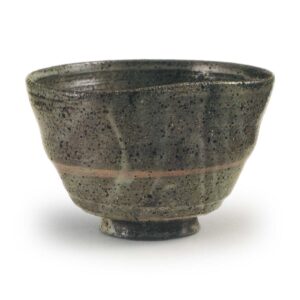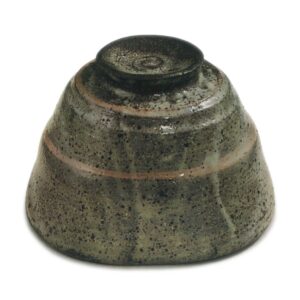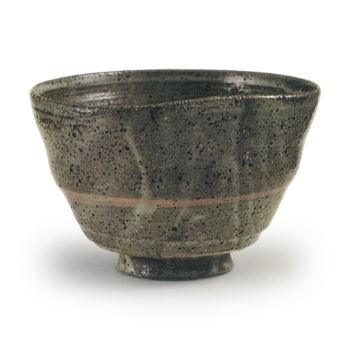

Height: 8.3 to 8.5 cm
Diameter: 12.0 to 12.7 cm
Outer diameter of foot ring: 5.2 to 5.3 cm
Height of foot ring: 1.1 cm
The Asahiyaki pottery of Joshu-Uji is one of the most famous of the seven Enshu kilns, and this tea bowl is a famous product that is often cited as the best of the Asahiyaki wares, and is named for the brush marks that run around the body of the bowl.
The old kilns of Asahiyaki were apparently located by the side of the old temple Keishin-in, which faces the Uji River, and were started by Okumura Jiroemon around the Keicho era and continued until around the Keian era, but it is said that they then temporarily ceased, and the name Asahiyaki is thought to be named after the nearby Asahiyama mountain and to be a signature of Kobori Enshu.
As the family of the tea master of Uji, Kanbayashi, often presented boxes of tea to the lord of the area, it is said that Enshu had them make Asahi tea bowls for him, and it seems that the kilns were originally created for tea utensils, and in particular, there are many works that are excellent in the style favored by Enshu. The elegant style of the thinly made tea bowls is exactly the same as that of the seven kilns favored by Enshu, such as Takatori and Kagehito, and they can be said to be the flowers of the national tea bowl. The Asahi mark is stamped on the foot of the tea bowl, and the early ones are said to be written by Enshu, and are commonly called the Enshu mark.
The “Asahi” mark, in which the “morning” kanji is turned into a table, is said to be the work of Kobori Enshu and is called the Enshu mark.
The body of the tea bowl is a good example of the characteristics of the old Asahi style favored by Enshu, and it has a brownish clay body similar to that of Ueno clay, a slightly opaque gray glaze, black sesame-like glaze spots, brush marks, etc., and in addition to its elegant workmanship, it also has a good basic shape.
The thinly-made, finely-turned pot has a slightly hollowed rim and a slightly bulging body, and to emphasize this, a single brushstroke has been applied to the base of the pot, and then again at the foot, where the pot has been turned on the wheel twice to tighten the shape.
The foot ring is also neat and elegant, but it is sharp and open at the outside, and the strength is further added by the one-stroke side-taking. The foot ring is also elegant, and the Enshu seal is stamped on the inside.
The ash glaze that has been applied to the entire surface is somewhat translucent, and the glaze has a bluish tinge, with patches of moss-green and black sesame seeds, creating an indescribable natural beauty.
The brush marks are a subtle reddish-brown, creating a beautiful contrast with the green and red.
The inside is also beautifully white, showing the effect of the maku-yō glaze.
The accompanying items are
Inner box: black lacquer
Outer box: paulownia wood, plain finish, with the inscription “Asahi, tea bowl, body strap” on the lid
Transmitted. It was originally owned by the Kanazawa tea master Nohisa, and later passed into the hands of the Osaka Shima family, before coming into the possession of the current owner.



